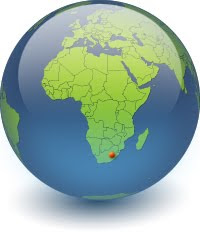It was only twenty minutes down from the pass to the tiny town of Malealea, where we would stay for two nights. The campsite had closed down the camping area for the winter, so we were able to stay in their bungalows for free. I dropped my bags off in the room and walked over to the nearby lounge while Chad cooked dinner in the adjacent kitchen. Many of the places we have stayed on the Nomad tour have nice indoor lounges with fireplaces, cushy couches and chairs, and electrical outlets for charging laptops and camera batteries. Although Lesotho wasn't as cold as we were expecting, it was still nice to warm up by the fire.
In the morning, I opened the door to the small bungalow I shared with Wesley, and sunlight illuminated the dark room. There on the corner of my bed crawled a gigantic caterpillar with long, feathery, stinging hairs. Luckily it never made it up to the bare skin around my face or neck during the night. A girl on the Oasis trip was stung by a caterpillar on her neck while she slept in her tent, and it caused a painful, swollen rash.
After breakfast, we went on a tour of the village of Malealea. We visited the small local general store to buy some candy to give to children at the school we were visiting later. We learned about home-made beer-brewing techniques, tried the local tea, and visited a sheep kraal (corral).
After two hours, we arrived at the school. All the houses and other buildings in the village are spread out, and there are few roads – we walked through crop terraces to get to the school. We met some of the teachers and students, and the school administrator told us about the hardships faced by the school. Some of the students wore uniforms. Many did not. Uniforms are a major expense for families in this poor region. Students become bilingual at an early age because classes are taught in both English and Sesotho, the language of Lesotho. In fact, Lesotho has one of the highest literacy rates in Africa. We left just as the children began to eat their lunch of maize meal porridge provided by the school. Our last stop on the way back was at a preschool, where the children performed a dance for us, and the teachers joined in. The people of Lesotho are called Basotho, and they are among the friendliest I have encountered in Africa.
After lunch, I set out on a long hike through the surrounding landscape. Most of the group chose to do the trek on horseback, but I rode a horse in Zimbabwe, and I also wanted to focus on taking photographs. We walked for ages from the hilltop where Malealea sits down into a river valley. The river at the bottom is unique – in certain areas, it runs completely through a channel of solid rock that has been worn into smooth, wave-like shapes by the flowing water. We had to cross the river numerous times as it snaked back and forth through the steep walls of the mountains, and each crossing was more treacherous than the last. We balanced on slippery rocks, jumping from one to another across the fast-flowing water. The river was not deep, but none of us wanted to get wet. It probably would have been easier to just wade barefoot to the other side. We finally made it to the waterfall, where we met the others who came on horseback. We admired the sheltered pool and the mossy rock walls while we refueled on cereal bars, and then we trekked back along the river and up the hillside to Malealea.








No comments:
Post a Comment